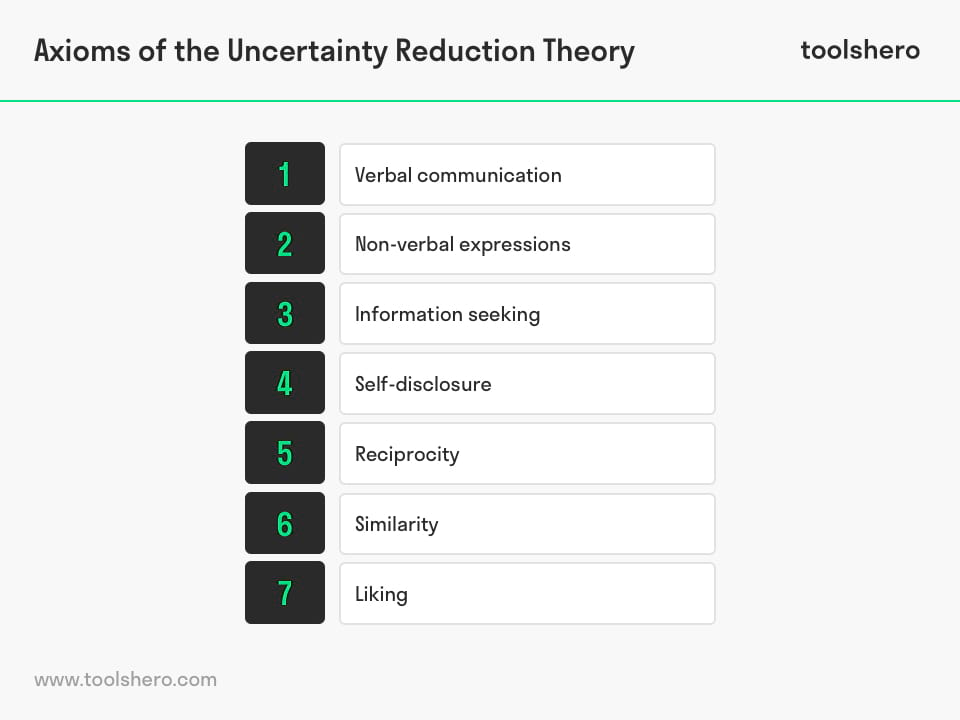Uncertainty Reduction Theory: Examples and Definition

Uncertainty Reduction Theory: this article provides a practical explanation of the Uncertainty Reduction Theory. After reading, you will understand the basics of this powerful communication theory.
Other highlights include: examples of Uncertainty Reduction Theory, the axioms of the theory and its stages of interaction.
What is the Uncertainty Reduction Theory?
Charley Berger and Richard Calabrese created the Uncertainty Reduction Theory in 1975 in an attempt to describe the communication process when people meet for the first time.
The theory is concerned with how people communicate and how knowledge is shared and understood. This theory of interpersonal communication is a result of Berger’s and Calabrese’s research ‘Some Explorations in Initial Interaction and Beyond: Towards a Development Theory of Interpersonal Relationship’.
According to the Uncertainty Reduction Theory, it is a typical human trait to doubt future actions of a person with one have just met.
Berger and Calabrese next concluded that if one meets a new person, both have many questions about each other. For this reason, the Uncertainty Reduction Theory focusses on the predictability of the behavior of people.
Definition
Based on the Uncertainty Reduction Theory, people should retrieve general demographic information about other people to reduce the level of uncertainty they have about other people behavior.
The theory additionally shows that as soon as the necessary information about interactants has been retrieved, it will be easier for both predict behaviors and actions of each other. Other strategies to reduce uncertainty include the passive strategy, active strategy and interactive strategy.
According to the Uncertainty Reduction Theory, people can have cognitive- and behavioral uncertainty. Both might occur when two people meet for the first time. Cognitive uncertainty is concerned with the beliefs and attitudes, and thus, deals more with discovering who one is.
Behavioral uncertainty is concerned with how an individual would act in a particular situation. For instance, one could have doubts about why another person act in a specific way, and as a consequence, questions may arise that could make the individual uncertain.
This Theory is created based on various axioms. Axioms are statements without proof, but which are generally accepted. It is can additionally also be used for a starting point for discussion. It is expected that because of different axioms, the level of uncertainty reduces. In addition, the theory has classified conversations of interactants in stages. These are later described together with the axioms.
Uncertainty Reduction Theory examples
The Uncertainty Reduction Theory can be applied in any situation because everyday life demonstrates to full of uncertainty, in terms of communication. For instance, people take public transport, and unconsciously they communicate with the transport carriers and passengers and never really know how others would think or react.
Another example can be that an individual is about to make an appointment or when two employees communicate with each other and who have never met in the past. Uncertainty can for this reason be found every day in human behavior.
Axioms of the Uncertainty Reduction Theory

Figure 1 – The Seven Axioms of the Uncertainty Reduction Theory. Do you want to learn more about communication?
Verbal communication
Verbal communication is concerned with the number of words that are exchanged during the initial conversation between interactants. It is expected that participants in the conversation have a sense of uncertainty when they first meet, but as more words are exchanged, the uncertainty diminishes and the interactants communicate more easily. As the uncertainty diminishes, communication among two people increases.
Non-verbal expressions
Non-verbal expressions are expressions like hand gestures, eye contact, and the physical distance between two people. As stated in the Uncertainty Reduction Theory, a relation exists between the number of non-verbal expressions and the level of uncertainty.
It is believed that if a person shows more positive non-verbal expressions such as eye contact and smiling, the level of uncertainty of the other person diminishes. When this happens, the interaction between two individuals will increase because of a higher level of trust.
Information seeking
As the level of uncertainty diminishes, the interactants ask more simple questions. These questions could be demographically related because these are simple questions to answer, but also questions about one’s job position or where one grew up or lives.
Personal information about attitudes and opinion are at this stage not shared yet. Both interactants seek information by observing the other person.
According to the Uncertainty Reduction Theory, when the level of uncertainty decreases further, the number of questions asked will also be lower.
Self-disclosure
According to the Uncertainty Reduction Theory, in the self-disclosure axiom, it is believed that individual share more personal information to gain the trust of the other interactant. This happens because the level of uncertainty decreases significantly.
If for some reason one of the interactants still have a high level of uncertainty, it is likely that one of the interactants will share limited personal or sensitive information.
Reciprocity
Reciprocity is concerned with the degree to which interactants expect another to share similar information if one has shared something.
For example, in the self-disclosure example, if one of the interactants share personal information, it is then expected that the other person also shares similar information.
In this way, the level of uncertainty will decrease for both, and interaction increases. Based on the Uncertainty Reduction Theory, as the level of uncertainty diminishes, the need to share personal information decreases because of a higher level of trust.
Similarity
The Uncertainty Reduction Theory additionally found that the level of uncertainty also decreases when interactants share the same interests. Sharing the same interest eliminate communication barriers and enable the interactants to build a relationship.
Sharing the same interests can be related to many subjects, including personal matters such as opinions but also hobbies.
Liking
Liking deals with the emotional aspects of interactants. It is believed that if participants of a conversation have positive feelings about each other, the level of uncertainty will be lower, and the number of conversations increases.
As a result, the interactants quickly build a relationship. According to the Uncertainty Reduction Theory, it is additionally expected that when interactants share positive feelings, it is easier for both to understand another.
The Uncertainty Reduction Theory stages of interaction
The Uncertainty Reduction Theory has classified interactions among interactants into three stages which are underneath described. Each stage presents behaviors that interactants like or dislike.
Based on the interactants’ preferences, it is decided if communication will be continued. The stages are as follow:
The entry stage
Since this is the first stage of interaction between two individuals, communication is mostly based on observing one’s behavioral norms and values. These could include watching how one greets or smile.
Another essential part of the entry stage of the Uncertainty Reduction Theory is to exchange basic information, such as information about one’s job position or place of residence, as previously described in the first axioms.
When there is a mutual interest among the interactants, the relationship will further develop and reach the next stage.
The personal stage
In the personal stage of the Uncertainty Reduction Theory, it is expected that the interactants actively attempt to identify one’s norms, values, and attitudes. The goal is to find mutual indicators that help to develop the relationship further.
Many times, this stage is reached after the interactants have had conversations various times. As the interactants communicate more frequently in this stage, more personal and sensitive information is additionally shared.
The exit stage
The exit stage of the uncertainty reduction can also be seen as an evaluation of the relationship phase.
Interactants will, in this stage, determine if the relationship is going to develop further or if it is going to end. Further development of the relationship can be dependent on various factors.
For instance, if a relationship has to build for economic interests, the relationship will probably further develop, but if the interactants have no mutual interests, further development might not be an option.
Reasons to reduce uncertainty
Reducing the level of uncertainty among interactants is most likely depended on the importance of future communication with the interactants.
For instance, if an individual is taking pubic transport and meet another person on the way, it might not be necessary to learn from this person.
But if an individual starts a new job position at a new company, the new employee will have an asset if the individual knows how employees and managers think and react to particular situations. In this case, it makes sense to learn more about the people on the work floor and develop relationships.
Another motivation can be that interactants can reward another. Many times, this type of motivation is applied to potential love partners, but it can also be based on friendships with people who can make a difference on both interactants.
In both cases, it makes sense to reduce the level of uncertainty, and for this reason, communication barriers will be eliminated, and relationships are further developed.
Final word on the Uncertainty Reduction Theory
Everyone has a level of uncertainty when people first meet. The motivation to develop a relationship, and thus, lower the level of uncertainty, is depended on the situation and individual’s goal.
According to the Uncertainty Reduction Theory, uncertainty is reduced when interactants have various conversations in which they learn from each other. The more words are exchanged, the lower the level of uncertainty. However, the environmental setting is crucial for determining if a relationship needs to be developed.
If a relationship is going to be developed, the likelihood is high that the relationship will go through the entry stage, personal stage, and exit stage.
The Uncertainty Reduction Theory was initially developed for real life communication. Critics have questioned the applicability of the theory in computer mediated communication (CMC). Critics argue that the theory might be partially effective in computer communication.
It’s Your Turn
What do you think? Are you familiar with Uncertainty Reduction Theory? Do you recognize the explanation or do you have more suggestions? What is your experience with uncertainty reduction?
Share your experience and knowledge in the comments box below.
More informaton
- Bradac, J. J. (2001). Theory comparison: Uncertainty reduction, problematic integration, uncertainty management, and other curious constructs. Journal of Communication, 51(3), 456-476.
- Gudykunst, W. B., & Nishida, T. (1984). Individual and cultural influences on uncertainty reduction. Communications Monographs, 51(1), 23-36.
- Gudykunst, W. B., YANG, S. M., & Nishida, T. (1985). A cross‐cultural test of uncertainty reduction theory: Comparisons of acquaintances, friends, and dating relationships in Japan, Korea, and the United States. Human Communication Research, 11(3), 407-454.
- Kramer, M. W. (1999). Motivation to reduce uncertainty: A reconceptualization of uncertainty reduction theory. Management Communication Quarterly, 13(2), 305-316.
- Parks, M. R., & Adelman, M. B. (1983). Communication networks and the development of romantic relationships: An expansion of uncertainty reduction theory. Human Communication Research, 10(1), 55-79.
- Sunnafrank, M. (1986). Predicted outcome value during initial interactions: A reformulation of uncertainty reduction theory. Human Communication Research, 13(1), 3-33.
How to cite this article:
Zeeman, A. (2019). Uncertainty Reduction Theory. Retrieved [insert date] from Toolshero: https://www.toolshero.com/communication-methods/uncertainty-reduction-theory
Published on: 12/09/2019 | Last update: 10/27/2022
Add a link to this page on your website:
<a href=”https://www.toolshero.com/communication-methods/uncertainty-reduction-theory/”>toolshero: Uncertainty Reduction Theory</a>






